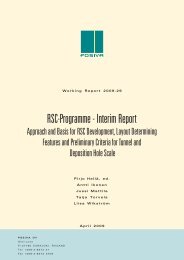Bentonite Mineralogy Part 1: Methods of Investigation - Posiva
Bentonite Mineralogy Part 1: Methods of Investigation - Posiva
Bentonite Mineralogy Part 1: Methods of Investigation - Posiva
You also want an ePaper? Increase the reach of your titles
YUMPU automatically turns print PDFs into web optimized ePapers that Google loves.
3. 7 Exchangeable cations and cation exchange capacity (CEC)<br />
21<br />
In clay minerals, exchangeable cations are situated in interlayer positions and on outer<br />
surfaces and edges. They stabilize negative charges that on outer surfaces and edges are<br />
variable and depend on pH (Stumm, 1992). At pH 4 the outer surfaces and edges are<br />
supposed to have zero negative charge. In interlayer positions <strong>of</strong> expandable 2:1 clay<br />
minerals (smectite, vermiculite), most exchangeable cations are hydrated. They can<br />
easily be exchanged by cations from solution, provided that the ionic strength <strong>of</strong> the<br />
solution is high enough. In general, divalent cations like Ca 2 + and Mg 2 + (higher charge)<br />
tend to substitute for univalent cations like Na+ (lower charge) in the interlayer position.<br />
The cation exchange capacity (CEC) can be determined as sum <strong>of</strong> exchangeable cations.<br />
The standard cations for determining exhangeable cations and measuring cation<br />
exchange capacity areNa+, NH/, and Ba 2 +. Sodium is one <strong>of</strong> the exhangeable cations<br />
itself. NH4 + is <strong>of</strong>ten used as standard method but it may form inner-sphere complexes<br />
with 2: 1 layer clays and may substitute for cations in easily weathered primary soil<br />
minerals (Stumm, 1992). Barium precipitates as sulfate if sulfur is present in the<br />
sample. Most <strong>of</strong> the bentonites to be examined in this project contain sulphur (e.g., MX-<br />
80: 2700-3200 mg/kg; Friedland clay: 650 mg/kg; Milos: 5600-6600 mg/kg; Pusch,<br />
2002). Cesium is used in many laboratories.<br />
Grain size <strong>of</strong> the material used for the determination <strong>of</strong> CEC plays an important role.<br />
CEC <strong>of</strong> bulk material is definitely lower than that determined <strong>of</strong> its clay fraction.<br />
Another question is, how does suspending and sedimentation in deionized water change<br />
the clay. A small part <strong>of</strong> the exchangeable cations are probably dissolved.<br />
<strong>Methods</strong> used in different laboratories:<br />
- Meier & Kahr (1999): Cu-triethylenetetramine method, pH 4- 9<br />
- Bergaya & Vayer (1997): Cu ethylenediamine complex<br />
- Cuevas et al. (2002): 1 M ammonium acetate at pH 8, CEC as sum <strong>of</strong> exchangeable<br />
cations<br />
- Emmerich & Kahr (2001): ammonium acetate at pH 7<br />
- Emmerich et al. (2001): exchangeable cations were removed by washing five times<br />
with 25 ml <strong>of</strong> a 1 M ammonium acetate solution (pH 7) for 12 h. Excess ammonium<br />
was removed by washing six times with ethanol. All supematant liquids were<br />
collected. For the CEC determination, the HN4+ was exchanged by Na+. Liberated<br />
NH3 was transferred by steam distillation in a distillation unit into a Erlenmeyer flask<br />
and titrimetrically determined.<br />
- Madsen (1998): ammonium acetate, pH 7, washing with ethanol<br />
- Churchman et al. (2002): leaching with 1 M NH 4Cl<br />
- Kahr & Madsen (1995): methylene blue, only for Na-forms<br />
- Cara et al. (2000): complexometric titration based on the saturation <strong>of</strong> clay by a<br />
Mg 2 + solution, addition <strong>of</strong> an excess <strong>of</strong> EDTA, and titration <strong>of</strong> this excess by using a<br />
Mg 2 + solution<br />
- Churchman (2002): XRF analysis <strong>of</strong> a barium-saturated sample

















